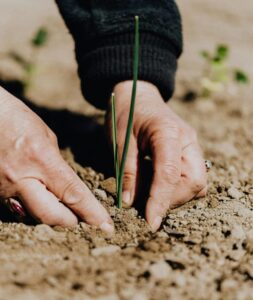Introduction
This page deals with that part of the supply chain where the product is packaged for marketing.
“Packaging” can include rigid and flexible plastic containers, cardboard containers, plastic bulk bins, punnets and trays for fruit and vegetables, sachet machines, tinplate pails and cans and other metal containers, polyfoam, polystyrene, as well as the equipment used prepare the product for the market.
A walk along any fresh produce market floor will emphasise the role of packaging in promoting fresh produce. Nothing looks better than a neatly stacked row of pallets boasting an attractive, branded, quality product for sale. (The contrast is brown, unattractive cartons, often bent and buckled, offering inferior quality to the cheap-line buyer).
Labelling legislation came into effect from 2012, governing the use of terms like “free range”, “organic”, “free range” etc. The legislation stems from the Department of Health’s Labelling and Advertising of Foodstuffs (regulation R146/2010), but detailing and enforcing these protocols is the responsibility of the Department of Agriculture. Coupled with the Consumer Protection Act (CPA), it means that labelling of products will require more thought, accuracy and caution than in the past.
The development of Africa’s handling systems and cold chain potential is vital in promoting intra-Africa trade.
Packaging in agriculture
- A major trend in the food industry is to make packaging more environmentally friendly and to increase the rate of recycling.
- Local fresh produce buyers have refined logistics to where produce is packed in the field and stays in that container all the way through to the retailer’s shelf.
- Bulk bins are used, but this is for produce that is intended for juicing.
- Computerisation (bar coding) makes it possible for the producer or purchaser to trace any pallet, bulk bin or carton from the farm to the supermarket throughout the supply chain. For high value products RFID (Radio Frequency Identification Discs) tags are increasingly being used to counter fraud and control inventories.
- Some of the repacking takes place overseas for two reasons: (1) to recheck the quality of the fruit received, and (2) to react quicker to the market demands.
Source: Packaging SA
Read about requirements for Food Business Operators (FBOs) on the Directorate Food Safety and Quality Assurance pages at www.nda.gov.za. Packhouses are included in this category.
Some notes
A NOTE ON WOOD PACKAGING
The International Standard for Phytosanitary Measures Guidelines for regulating wood-packaging material in international trade, ISPM 15, covers wood-packaging material such as pallets, dunnage, crating, packing blocks, drums, cases, loading boards, pallet collars and skids, which can be present in any imported/exported consignments. Treated wood-packaging material should bear the appropriate International Plant Protection Convention (IPPC) mark to certify that the wood-packaging material has been subjected to the approved phytosanitary measure.
RECYCLING AND BIODEGRADABLE PACKAGING
- Find information about recycling on the Packaging SA website, www.packagingsa.co.za.
- Visit the Plastics SA website, www.plasticsinfo.co.za.
- Responsible Packaging Management Association of Southern Africa https://rpmasa.org.za
- Biodegradable Future https://biodegradablefuture.com They have developed an additive for plastic that will naturally biodegrade when it ends up in a landfill, ocean or soil
- Good for the Ground www.goodfortheground.co.za environmentally friendly packaging
- Green Home https://greenhome.co.za Biodegradable packaging
See also the following:
- Collect-a-can www.collectacan.co.za
- MPact www.mpact.co.za
- PET Recycling Company https://petco.co.za
- Polylefin Recycling Company www.polyco.co.za
- The Glass Recycling Company https://theglassrecyclingcompany.co.za
Role players
View the Premium Listings below (scroll down or click on “Premium Listings” on the Table of Contents to the right).
Further reference:
Associations
Fruit SA is a founding member of the recently formed Alliance for Sustainable Packaging for Foods (ASPF), a coalition of NGOs whose aim is to “encourage the adoption of a holistic and harmonized approach to food packaging regulation in order to achieve environmental sustainability without compromising on food safety and public health, and without increasing the environmental footprint of the food supply chain”. See www.allianceforsustainablepackaging.com/en
Training and Research
- Find the link to the “National Certificate: Fruit Packing and Grading Processes” qualification on the AgriSETA website, www.agriseta.co.za.
Cold storage
- Find the several options dealing with refrigeration at www.supermarket.co.za
Websites and publications
Visit websites mentioned earlier on this page.
- A Handbook of Packaging Technology is a “most valuable information source for the African packaging industry” and is the prescribed text book for students at the Institute of Packaging SA.
- Find packaging articles and reviews at www.b2bcentral.co.za/channel/sa-food-review/.
- Another publication is Packaging & Print Media. Visit www.packagingmag.co.za.
- Food & Beverage Reporter, which includes Packaging Reporter. See http://fbreporter.co.za.
- Book thirteen of the series Training manuals: cooperatives is called “Packaging, Pricing & Storage”. The books can be viewed at www.nda.gov.za. Also find the Info Pak “Regulating wood packaging material”.
- Find the “Packaging” option under retail at http://bizcommunity.com, the Bizcommunity website.
Some articles:
- Read our blog “Revolutionary Solutions for Recycling Expanded Polystyrene in South Africa’s Agricultural and Nursery Industries“.
- Jansen C. 2024, June 6. “Well-considered packaging is non-negotiable for food safety by choice, not by chance” . Fresh Plaza. Available at www.freshplaza.com/africa/article/9633106/well-considered-packaging-is-non-negotiable-for-food-safety-by-choice-not-by-chance/
- KLA. 2024, August 5. “How consumer demand is driving change in food packaging”. Bizcommunity. Available at www.bizcommunity.com/article/how-consumer-demand-is-driving-change-in-food-packaging-250757a
- USDA. 2024, April 26. European Union Finalizes New Rules for Packaging and Packaging Waste Reduction. Available at https://apps.fas.usda.gov/newgainapi/api/Report/DownloadReportByFileName?fileName=European%20Union%20Finalizes%20New%20Rules%20for%20Packaging%20and%20Packaging%20Waste%20Reduction_Brussels%20USEU_European%20Union_E42024-0012.pdf
- Collen C. 2024. April 25. “Alliance for Sustainable Packaging for Foods criticises PPWR [Packaging and Packaging Waste Regulation]”. Fruit Net. Available at www.fruitnet.com/eurofruit/alliance-for-sustainable-packaging-for-foods-criticises-ppwr/259988.article
- Kruger G. 2024, January 15. “FMCGs to prioritise packaging in 2024 or run the risk of losing customers “. Bizcommunity. Available at www.bizcommunity.com/article/fmcgs-to-prioritise-packaging-in-2024-or-run-the-risk-of-losing-customers-234207a






